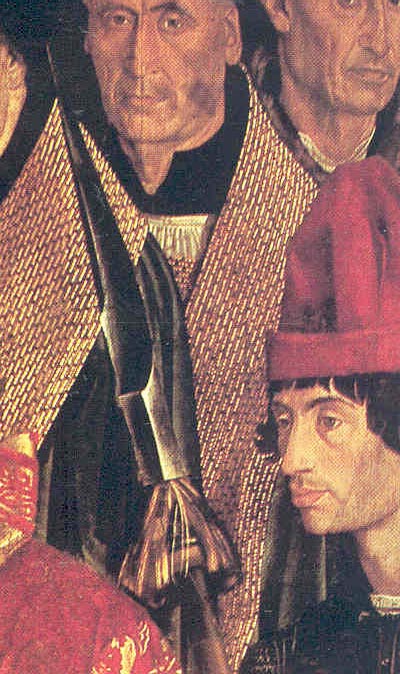Posts: 5,981 Location: Birmingham, Alabama
Fri 08 Sep, 2006 8:00 am
Polearm Details!
Posts: 614 Location: Atlanta Ga
Fri 08 Sep, 2006 8:08 pm
The buttcap is most interisting. You rarely see those these days, it's all pictures of the head.
Posts: 301 Location: Brisbane, Australia
Sat 09 Sep, 2006 12:42 am
Vouge
Thanks for these pics.......most interresting ! I managed to get a big tassle like that one a few months ago.......it was a tie-back for a heavy curtain and could be easily adapted. I have heard that they originally put tassels on pole arms to absorb blood during battle and stop the grip becomming slippery.......does anyone know if this is correct ?
BTW, the Gambeson that one of the guards is wearing isnt bad either !
Do you know the name of the artist and the title of this painting ?
Posts: 147
Sat 09 Sep, 2006 8:51 am
there is a tapastry in the met that shows a padded rondel on a pollaxe. the man holding it dosn't wear gauntlets.
Posts: 5,981 Location: Birmingham, Alabama
Mon 11 Sep, 2006 12:13 pm
Info about the painting:
Altarpiece of Saint Vincent (Archbishop panel)
Nu˝o Gonšalves
c. 1495
Museu Nacional de Arte Antiga, Lisbon
As for the tassles--tassles are a relatively late addition to polearms, which suggests that their purpose is primarily decorative or for easy identification in the field. The fact that we see tassles especially on ceremonial arms and on the arms of officers and elite guards is one indicator of this. Tassles certainly appear on more common arms as well, and it has been suggested that they help direct rainwater away from the bearer when on the march (it might otherwise collect on the head of the polearm and run down the haft). This may well be true, but it seems unlikely that it took a couple of centuries for folks to figure out that practical benefit. Ditto for the blood theory. It seems likely that if blood-slicked hafts were a problem, folks would have been using tassles much earlier.
Posts: 614 Location: Atlanta Ga
Mon 11 Sep, 2006 6:24 pm
Sean, I beleive I had a period source on the rainwater, but I can't recall where it was at present.
Posts: 5,981 Location: Birmingham, Alabama
Tue 12 Sep, 2006 8:59 am
M. Kelty posted this in an earlier thread on the subject of polearms:
'Art Of Warre'
Thomas Garrard,
1591
page 8
"...I will onelie say thus much more concerning the pikeman, that he
ought to have his Pyke at the point and middest trimmed with handsome
tassets, and a handle, not so much for ornament as to defend the
Souldiers bodie from water, which in raine doth runne downe alongst
the wood."
Sounds to me like "ornament" was recognized as at least part of the reason for tassles.
You
cannot post new topics in this forum
You
cannot reply to topics in this forum
You
cannot edit your posts in this forum
You
cannot delete your posts in this forum
You
cannot vote in polls in this forum
You
cannot attach files in this forum
You
can download files in this forum

